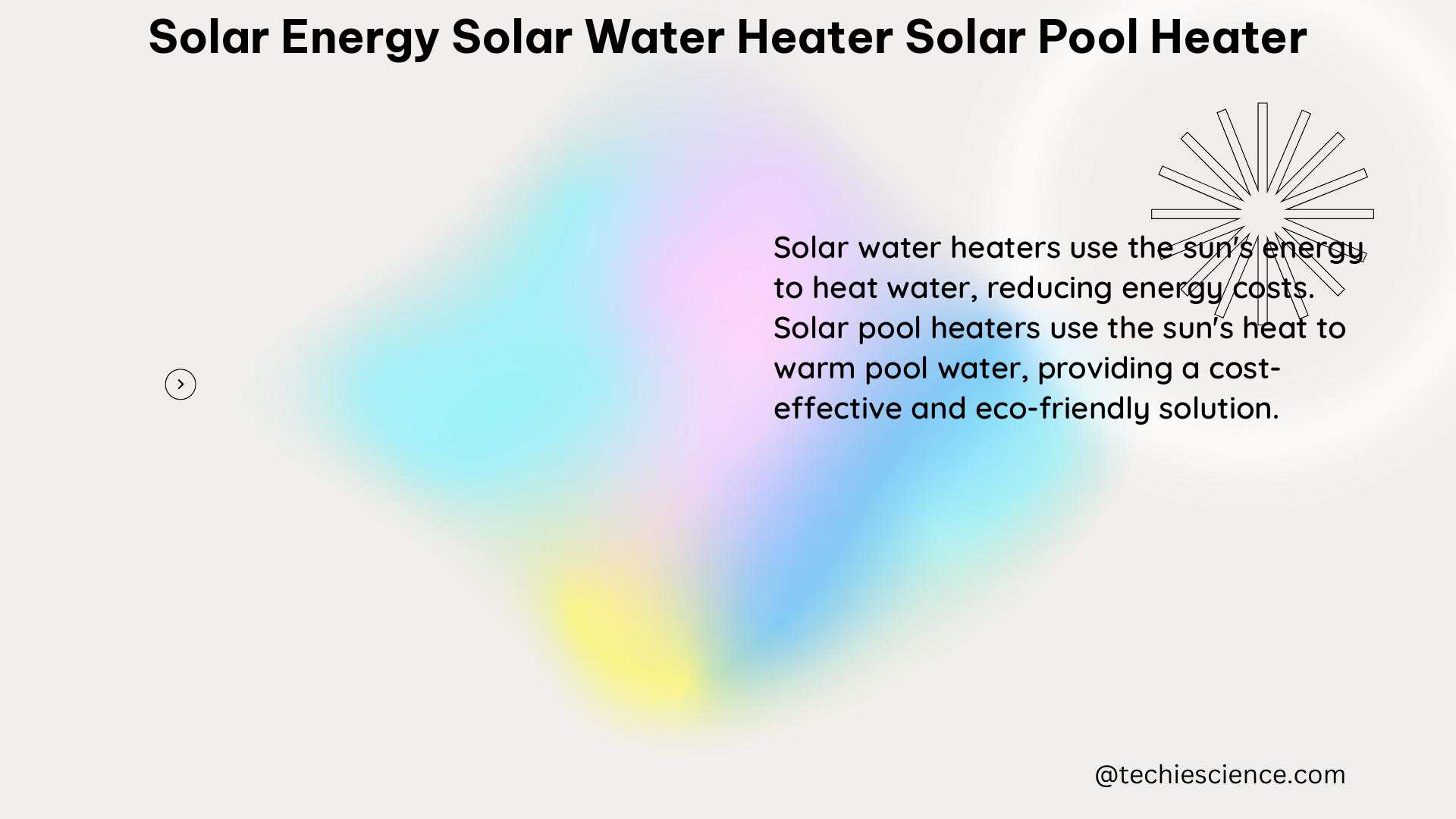Solar energy, solar water heaters, and solar pool heaters are increasingly popular technologies that harness the power of the sun to provide sustainable and cost-effective energy solutions. This comprehensive guide delves into the technical details and performance metrics of these systems, equipping you with the knowledge to make informed decisions and maximize their efficiency.
Solar Energy Fundamentals
The foundation of solar energy lies in the conversion of sunlight into usable forms of energy. The incoming solar radiation, which averages around 830 W/m² during tests, is the primary source of energy. However, the captured solar radiation is typically 65-75% of the incoming radiation, due to factors such as reflection, absorption, and conversion efficiency.
The efficiency of solar energy conversion is governed by the Shockley-Queisser limit, which states that the maximum theoretical efficiency of a single-junction solar cell is around 33.7% under standard test conditions. This limit is based on the principles of thermodynamics and the bandgap energy of the semiconductor material used in the solar cell.
To improve the efficiency of solar energy conversion, researchers have developed various techniques, such as:
- Multi-junction Solar Cells: These cells stack multiple semiconductor layers with different bandgaps, allowing for a broader spectrum of light absorption and higher overall efficiency, reaching up to 29.1% under concentrated sunlight.
- Perovskite Solar Cells: This emerging technology has shown promising results, with lab-scale efficiencies exceeding 25%, and the potential for low-cost, large-scale manufacturing.
- Concentrating Solar Power (CSP): CSP systems use mirrors or lenses to concentrate sunlight onto a smaller area, increasing the energy density and enabling the use of more efficient, but more expensive, solar technologies.
Solar Water Heaters

Solar water heaters are a practical application of solar energy, providing a sustainable and cost-effective solution for domestic hot water needs. The performance of these systems is typically measured by the Solar Energy Factor (SEF), which ranges from 1.0 to 11.0, with higher values indicating greater energy efficiency.
Another important metric is the Solar Fraction (SF), which represents the portion of the total conventional hot water heating load that is met by the solar water heater. Typically, the SF ranges from 0.5 to 0.75, meaning that the solar water heater can meet 50-75% of the total hot water demand.
The daily hot water energy and annual solar energy savings are also crucial factors in evaluating the performance of solar water heaters. For example, a system may provide 0.4105 therms/day of hot water energy, resulting in an annual solar energy savings of 174 therms/year. Assuming an energy cost of $1.50/therm, this would translate to an annual solar cost savings of $261.
The efficiency of solar water heaters is influenced by various design and installation factors, such as the type of collector (flat-plate or evacuated tube), the orientation and tilt angle of the collector, the storage tank size, and the climate conditions.
Solar Pool Heaters
Solar pool heaters are another application of solar energy, providing a sustainable and cost-effective way to heat swimming pools. The performance of these systems is typically measured by the Thermal Performance Rating, which is expressed in Btu/(ft²day) or kWh/(m²day) and reflects the solar energy collection efficiency.
The collector efficiency of solar pool heaters is generally in the range of 65-75%, meaning that 65-75% of the incoming solar radiation is captured and converted into useful heat. This heat is then transferred to the pool water, with a typical heat transfer of 1700 W (5800 Btu/hr) from 400 feet of coil.
The pool temperature increase on sunny days is typically around 0.2°C/day, while the heat loss on sunny warm days is approximately 0.1°C/day. These values can vary depending on factors such as the pool size, the surface area of the solar collector, and the flow rate of the pool water.
The pool size and tubing surface area are also important considerations in the design and performance of solar pool heaters. For example, a pool size of 70,000 liters (18,500 gallons) and a tubing surface area of 600 W/m² are common values.
Installation and Maintenance
The installation of solar energy, solar water heaters, and solar pool heaters requires careful consideration of various factors, including the solar resource, climate, local building codes, and safety issues. Proper installation is crucial to ensure the optimal performance and longevity of these systems.
Maintenance requirements for these systems typically include regular checks on pool chemical balance and filtering system for solar pool heaters, and general system inspections and cleaning for solar water heaters and solar energy systems.
Cost Comparisons
The cost-effectiveness of solar energy, solar water heaters, and solar pool heaters is an important consideration for many consumers. The cost per unit of energy can be used to compare the efficiency of these systems, with an example value of 37.20 Btu/day per dollar spent.
The collector cost and system cost can also vary widely depending on the specific technology, size, and installation requirements. For example, a solar collector may cost $387, while the entire system may cost around $3,000.
Conclusion
Solar energy, solar water heaters, and solar pool heaters offer promising solutions for sustainable and cost-effective energy generation and utilization. By understanding the technical details and performance metrics of these systems, you can make informed decisions and maximize their efficiency to meet your energy needs. This comprehensive guide has provided you with the necessary knowledge to navigate the world of solar energy and its applications.
Reference:
– Solar Energy Industries Association (SEIA)
– National Renewable Energy Laboratory (NREL)
– U.S. Department of Energy – Solar Energy Technologies Office

I am Subrata, Ph.D. in Engineering, more specifically interested in Nuclear and Energy science related domains. I have multi-domain experience starting from Service Engineer for electronics drives and micro-controller to specialized R&D work. I have worked on various projects, including nuclear fission, fusion to solar photovoltaics, heater design, and other projects. I have a keen interest in the science domain, energy, electronics and instrumentation, and industrial automation, primarily because of the wide range of stimulating problems inherited to this field, and every day it’s changing with industrial demand. Our aim here is to exemplify these unconventional, complex science subjects in an easy and understandable to the point manner.